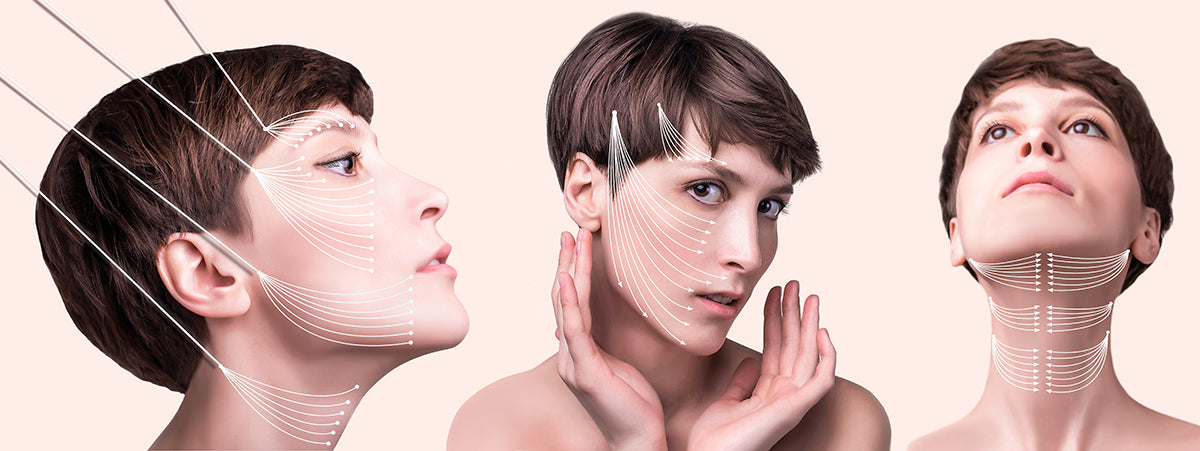How to Get a Non-Surgical Facelift, With Threads!
The first facelift was performed by Eugene von Hollander in 1901. The procedure was conducted on a Polish patient who wanted to improve the appearance of her cheeks and mouth by lifting. To achieve this lift, the surgeon made incisions near the hairline to remove loose skin, resulting in a visible lift. Since then, surgical techniques have evolved to include incisions in the hairline, around the ear, and even the back of the head. The demand for a less invasive facelift led to the development of a non-surgical anti-aging treatment know as thread lifting. When combined with an effective skincare routine, thread lifts can provide long-lasting, natural results. Thread lifts can be combined with other non-surgical options like injectables and skin resurfacing treatments to target multiple concerns.
What Are Thread Lifts?
A thread lift is a procedure wherein temporary, absorbable sutures are used to stitch and suspend portions of loose facial skin, pulling it back slightly. It improves skin laxity and restores skin firmness thereby resulting in a subtle but visible lift. Aside from lifting the skin, thread lifts also counteract the effects of aging by promoting collagen formation and healing responses of the body, which are important in fighting the effects of aging. Many changes occur in our body as we age, including a decreased production of collagen. This decrease in collagen results in a significant reduction in skin thickness and loss of volume.
While a surgical face lift provides a more dramatic result, thread lifts are low-risk procedures with minimal recovery time. There is also no need for heavy sedation and general anesthesia, allowing for a faster recovery.
: Specifically, thread lifts can improve the following cosmetic issues:
- Droopy eyelids
- Sagging jowls and cheeks
- Marionette lines
- Sagging skin on the neck
- Chest wrinkles
Thread lifts may also be used to rejuvenate other parts of the body including the upper arms, buttocks, breasts, and even the knees.

Advantages and Disadvantages
Another important advantage of thread lifts is its low-risk nature because it is less invasive. Even though some patients may experience some soreness, redness, or swelling, there is significantly less risk of scarring, severe bruising, or bleeding. In extremely rare cases, however, an infection can occur around the sutures. Nonetheless, infected sutures can be easily removed, and the patient’s face will just return to its prior state.
The cost of the procedure is also an important factor to consider. Because this is easier to perform than surgical facelifts, it is also more affordable. Aside from the cost, this procedure can also be done together with other nonsurgical procedures for better results.
Of course, every procedure has its advantages and disadvantages. The main disadvantages of a cosmetic thread lift are its subtle results. For this reason, patients need to have realistic expectations, and understand the limitations of this anti-aging procedure. Another disadvantage is that thread lifts are not useful in addressing blemishes on the skin’s surface because they are designed to lift and tighten the skin. Those in their late thirties to early fifties are the ideal candidate for thread lifts.
Thread Lift Types and Their Anti-Aging Purposes
Before scheduling your thread lift appointment, it is important to consider the desired outcome of the procedure. There are three main types of threads currently available: polydioxanone (PDO), polylactic acid (PLA) and polycaprolactone (PCA).
PDO
PDO (also known as Novathreads) threads are biocompatible sutures especially designed for safe re-absorption in the body. Theses sutures are made of polydioxanone, a biocompatible material used in cardio-thoracic surgery. PDO threads are placed superficially in the tissues and remain in place for as long as four to six months before reabsorption. There are several different varieties of PDO threads: mono, cog and screw. The cog threads are barbed sutures that are ideal for gathering loose skin, allowing for a better lift. Because of this, they are usually placed near the hairline to pull back the skin and lift the cheeks and jowls. On the other hand, mono threads are smooth sutures that produce a more subtle lift but are good for collagen stimulation. Screw threads have one or two intertwined threads around the needle and provide good volume restoration to sunken areas of the skin.
PLA
PLA threads (as found in the Silhouette Instalift) are also biocompatible temporary sutures but regenerate collagen over a longer period of time. Instead of being barbed or smooth, these sutures contain tiny cones to manipulate the tissue. Because of this, these sutures gather more skin and give rise to a more noticeable lift. PLA threads are designed to last longer than PDO threads with results lasting as long as three years.
PCA
PCA threads are bio-absorbable threads of synthetic origin. They work by regenerating collagen and causing a fibrotic reaction when the threads are absorbed into the skin. PCA lasts longer than both PDO and PLA threads. As the threads break down in the body, new collagen and hyaluronic acid are produced, providing new support for aging skin.
In sum, PDO threads are best for those wanting to revitalize or reposition their skin, but not lift. PLA should be considered for moderate to light lifting and PCA is used for a more noticeable lift. Due to the low-risk nature of the procedure and low cost, it is common for clients to receive thread lifts regularly.

How to Maintain Results
Thread lifts offer an innovative, effective, and affordable way to lift and tighten the skin. Thread lifts are bio stimulating and induce the development of collagen and hyaluronic acid in the skin. After a thread lift, it is important to continue taking care of your skin. A good at-home skin care routine that includes a gentle cleanser, serum, and moisturizer should help maintain results in between cosmetic procedures.
